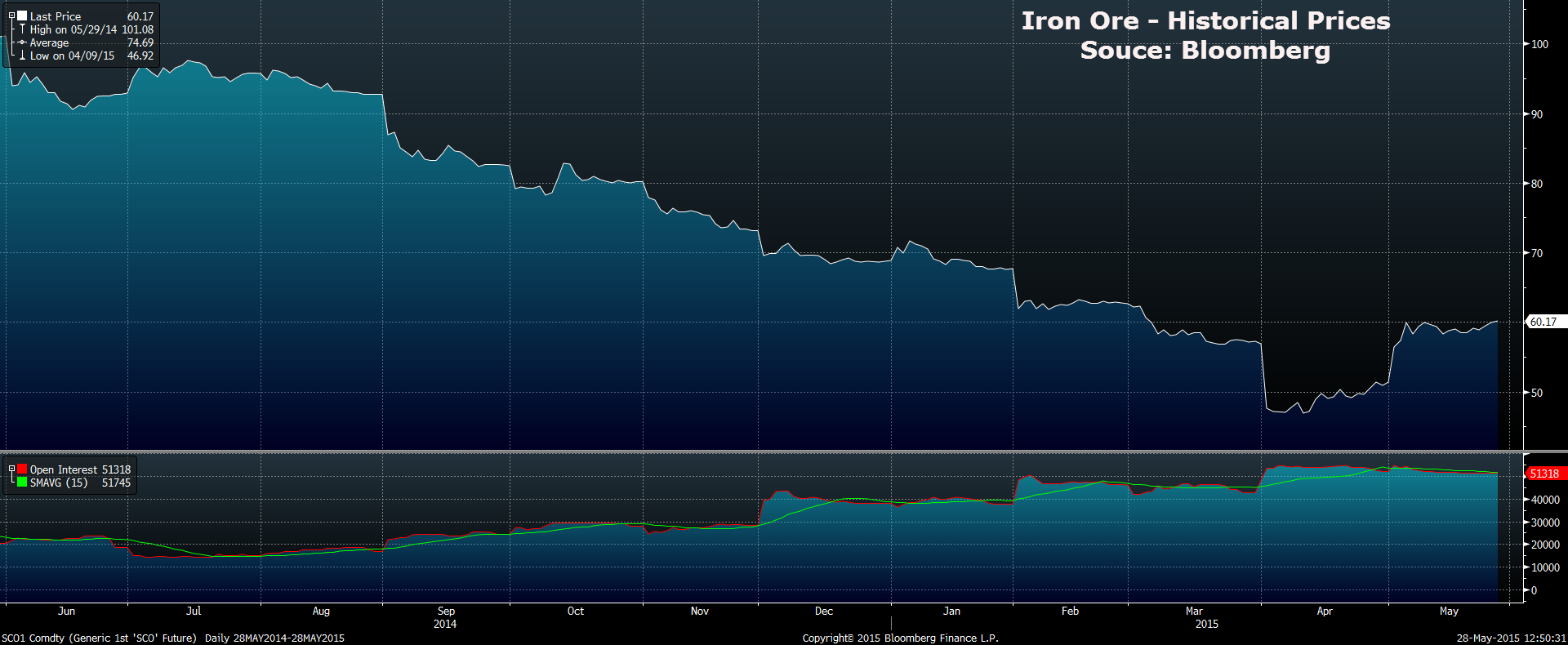The price of iron ore has continued to be driven lower, mainly through the low cost expansion projects within Australia and Brazil. Prices for the commodity have continued falling from last July’s, high of $94.75/t, to trade currently around the $60.00/t level. This significant fall has placed many of the smaller producers under pressure as well as the Australian government’s tax receipts. Subsequently, the viability of many of the smaller producers is at risk and this has led to a range of voices calling for a change in production strategy.
There is a view, perpetuated by the smaller mining concerns, that a cartel could be created to stabilise prices at a point where all market participants can benefit. Currently, two thirds of the world’s iron ore supply is controlled by three major producers. Accordingly, this alternate view would have the major players fix global iron ore prices at a point which would maximise profits for all within the industry.
In principle, further low cost expansions could be restricted, and prices allowed to stabilise at a higher point. This would potentially allow smaller operators to set prices on a steep curve at a point that would provide economic profits whilst the risk of increased competition or supply.
However, cutting production would likely fly in the face of the continual march towards efficiency within the mining plays. In fact, Goldman Sachs estimates mining efficiency is increasing within Australia, at a rate close to 4.0%/year. These gains in efficiency lead to significantly higher production whilst reducing operating costs and represent a shifting of the efficiency frontier.
Also, coordinating such an agreement amongst the three major participants would be extremely problematic. Historically, such agreements, evident within the oil industry, have been undertaken when there are one or two major competitors within the segment. Adding an additional party to any cartel agreement is likely to significantly complicate any predictive assessment of the competitive outcomes.
However, the elephant in the room is the potential production expansion that exists on the horizon over the next few years. Estimates from GS analysts show secondary tier producers as having nearly 100mt/year of new capacity to introduce within the next two years. Subsequently, any cartel operations would need to factor in the cost of absorbing the additional capacity expansions which are already underway. This is likely to represent a significant cost to any cartel members and would further complicate any predictive supply fixing strategy.
Overall, any move to introduce a cartel to the global iron ore market is likely to face significant problems in implementation. The commodity price is likely to come under increased downward pressure in the coming years as all of the expansion projects by 2nd tier producers come online. In our view, the price is likely to continue to decline back towards the $40/t mark through to 2017 and would be unlikely to lend itself to an implausible cartel strategy.
Risk Warning: Any form of trading or investment carries a high level of risk to your capital and you should only trade with money you can afford to lose. The information and strategies contained herein may not be suitable for all investors, so please ensure that you fully understand the risks involved and you are advised to seek independent advice from a registered financial advisor. The advice on this website is general in nature and does not take into account your objectives, financial situation or needs. You should consider whether the advice is suitable for you and your personal circumstances. The information in this article is not intended for residents of New Zealand and use by any person in any country or jurisdiction where such distribution or use would be contrary to local law or regulation. Knight Review is not a registered financial advisor and in no way intends to provide specific advice to you in any form whatsoever and provide no financial products or services for sale. As always, please take the time to consult with a registered financial advisor in your jurisdiction for a consideration of your specific circumstances.
Recommended Content
Editors’ Picks
EUR/USD clings to gains above 1.0750 after US data

EUR/USD manages to hold in positive territory above 1.0750 despite retreating from the fresh multi-week high it set above 1.0800 earlier in the day. The US Dollar struggles to find demand following the weaker-than-expected NFP data.
GBP/USD declines below 1.2550 following NFP-inspired upsurge

GBP/USD struggles to preserve its bullish momentum and trades below 1.2550 in the American session. Earlier in the day, the disappointing April jobs report from the US triggered a USD selloff and allowed the pair to reach multi-week highs above 1.2600.
Gold struggles to hold above $2,300 despite falling US yields

Gold stays on the back foot below $2,300 in the American session on Friday. The benchmark 10-year US Treasury bond yield stays in negative territory below 4.6% after weak US data but the improving risk mood doesn't allow XAU/USD to gain traction.
Bitcoin Weekly Forecast: Should you buy BTC here? Premium

Bitcoin (BTC) price shows signs of a potential reversal but lacks confirmation, which has divided the investor community into two – those who are buying the dips and those who are expecting a further correction.
Week ahead – BoE and RBA decisions headline a calm week

Bank of England meets on Thursday, unlikely to signal rate cuts. Reserve Bank of Australia could maintain a higher-for-longer stance. Elsewhere, Bank of Japan releases summary of opinions.
